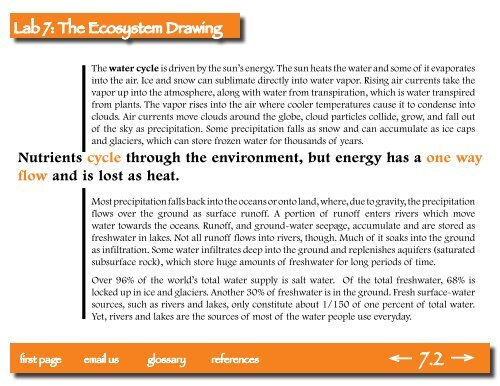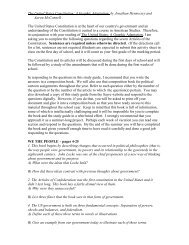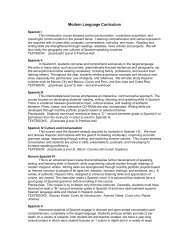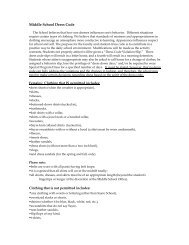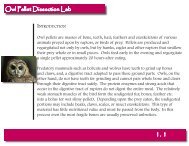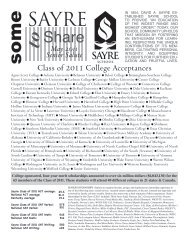Lab 7 Identifying Limiting Nutrient - Sayre School
Lab 7 Identifying Limiting Nutrient - Sayre School
Lab 7 Identifying Limiting Nutrient - Sayre School
Create successful ePaper yourself
Turn your PDF publications into a flip-book with our unique Google optimized e-Paper software.
<strong>Lab</strong> 7: The Ecosystem Drawing<br />
The water cycle is driven by the sun’s energy. The sun heats the water and some of it evaporates<br />
into the air. Ice and snow can sublimate directly into water vapor. Rising air currents take the<br />
vapor up into the atmosphere, along with water from transpiration, which is water transpired<br />
from plants. The vapor rises into the air where cooler temperatures cause it to condense into<br />
clouds. Air currents move clouds around the globe, cloud particles collide, grow, and fall out<br />
of the sky as precipitation. Some precipitation falls as snow and can accumulate as ice caps<br />
and glaciers, which can store frozen water for thousands of years.<br />
<strong>Nutrient</strong>s cycle through the environment, but energy has a one way<br />
flow and is lost as heat.<br />
Most precipitation falls back into the oceans or onto land, where, due to gravity, the precipitation<br />
flows over the ground as surface runoff. A portion of runoff enters rivers which move<br />
water towards the oceans. Runoff, and ground-water seepage, accumulate and are stored as<br />
freshwater in lakes. Not all runoff flows into rivers, though. Much of it soaks into the ground<br />
as infiltration. Some water infiltrates deep into the ground and replenishes aquifers (saturated<br />
subsurface rock), which store huge amounts of freshwater for long periods of time.<br />
Over 96% of the world’s total water supply is salt water. Of the total freshwater, 68% is<br />
locked up in ice and glaciers. Another 30% of freshwater is in the ground. Fresh surface-water<br />
sources, such as rivers and lakes, only constitute about 1/150 of one percent of total water.<br />
Yet, rivers and lakes are the sources of most of the water people use everyday.<br />
email us<br />
glossary 7.2


